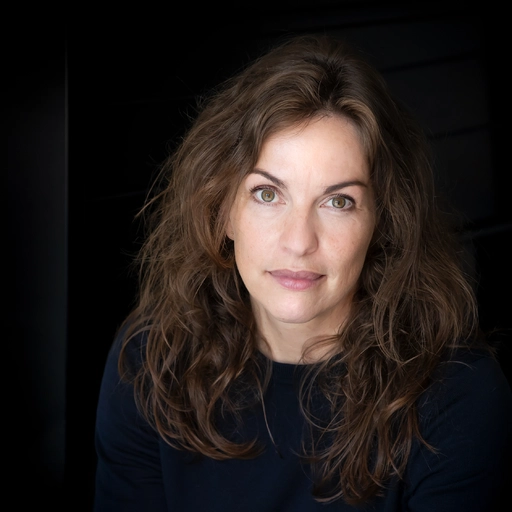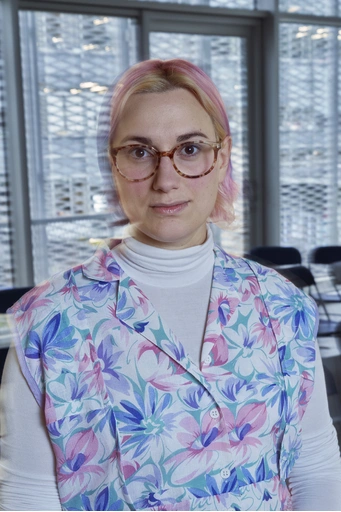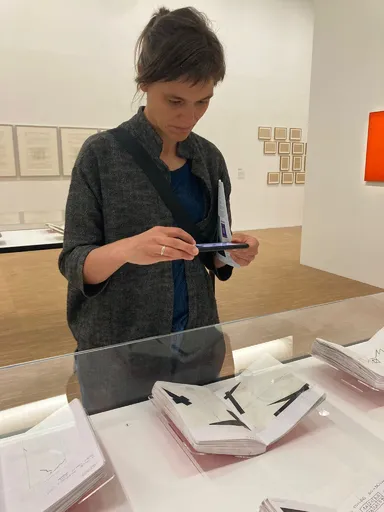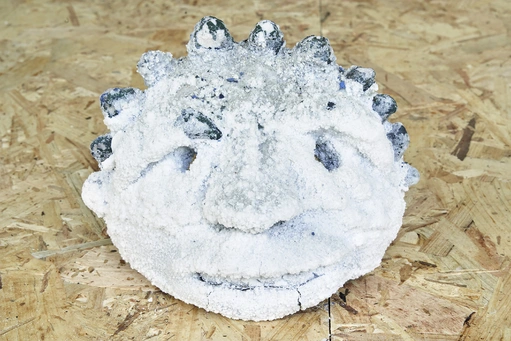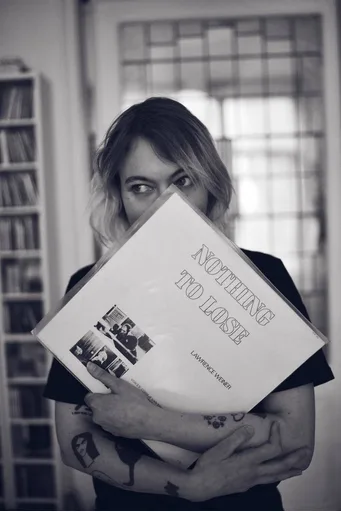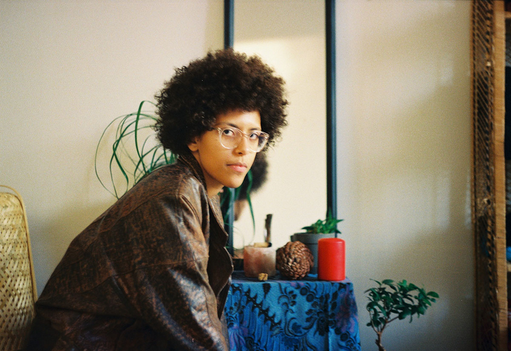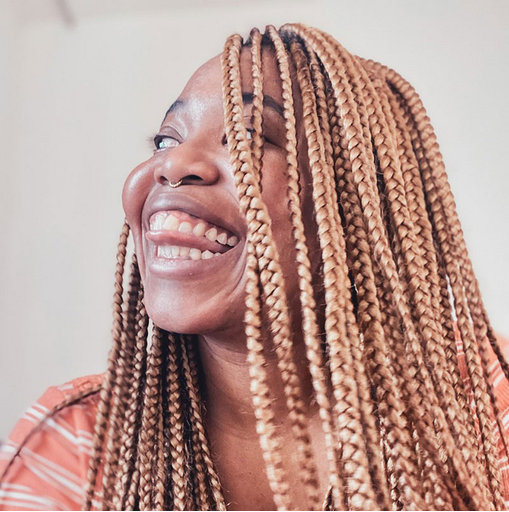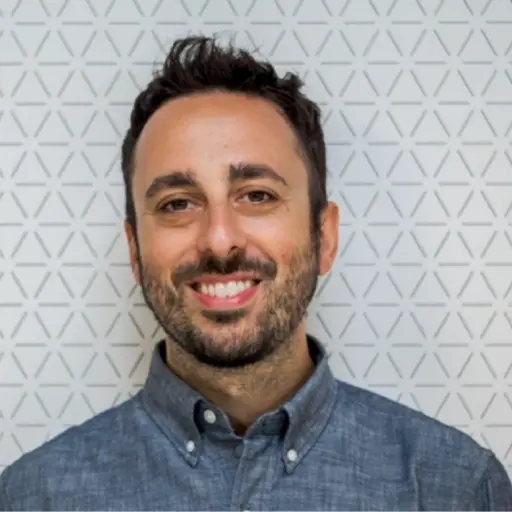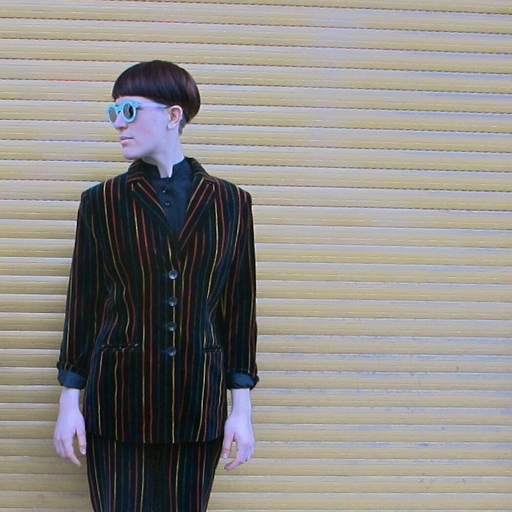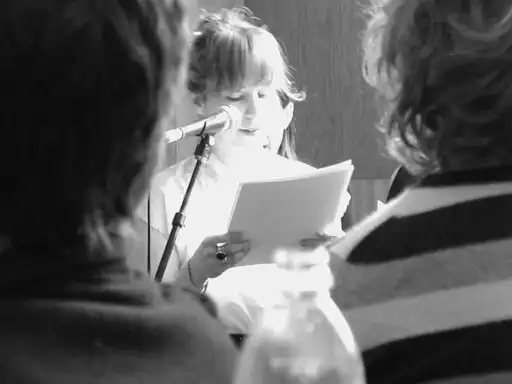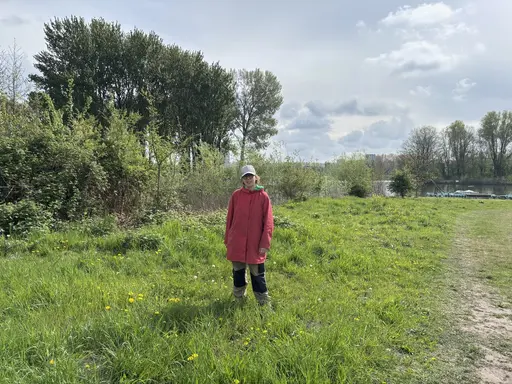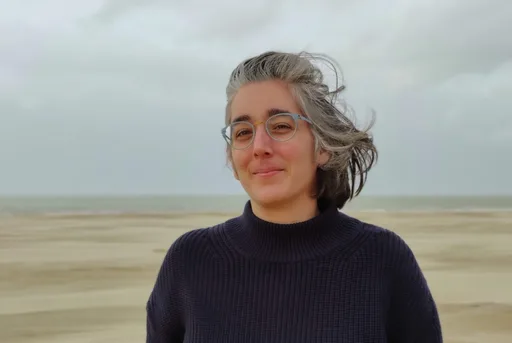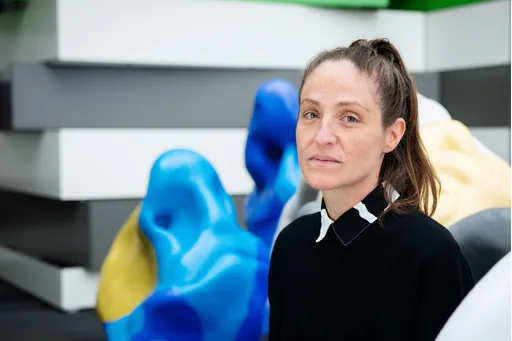The Climate Imaginaries at Sea festival took place from 19 April to 25 April 2024 in Amsterdam. An event for artistic and participatory research practices that speculate on possible futures in and around water. It was an exciting week with two exhibitions, an open studio day programme, the launch of the second issue of the Making Waves zine, a closing concert and more. In this article we look back on the festival and on the first year of the three artistic research studios of Climate Imaginaries at Sea.
This is a video recording of the open studio day programme Studio Encounters on Water #2 of the Climate Imaginaries at Sea festival, at Perdu on 23 April 2024. With talks by Leanne Betasamosake Simpson, Mikki Stedler, Joy Brandsma, Janine Armin, Carlo De Gaetano, Femke Dekker (Loma Doom), Müge Yilmaz, Kim Spierenburg, Claudine Arendt, Katía Truijen & René Boer (Loom Collective) and Marialena Marouda.
A year ago, we launched the artistic research studios of Climate Imaginaries at Sea, an initiative foregrounding artistic inquiry into sea-level rise. Three distinct artistic research studios were formed, each dedicated to a critical perspective on rising sea levels—perspectives we considered warranting more attention and consideration.
At the Amsterdam University of the Arts, Laura Cull Ó Maoilearca and her team have established a studio exploring Global South and Indigenous perspectives. Sabine Niederer and the Visual Methodologies Collective initiated a studio for Interspecies Inquiry at the Amsterdam University of Applied Sciences. At the Gerrit Rietveld Academy, Patricia de Vries and her research group on Art and Spatial Praxis started a studio focusing on Material Research.
Joy Brandsma, Dorothy Blokland, Müge Yilmaz, Carlo De Gaetano, Femke Dekker, Kim Spierenburg, Amanda Piña, Leanne Betasamosake Simpson, Mikki Stelder, Anne Dessing, and Janine Armin are among the artistic researchers who explore these perspectives as part of the studios. Over the past year, they’ve worked with students from different schools and departments, gone on field trips, deep-dived into archives, exchanged their practices across studios, and presented their (ongoing) work in public presentations.
At the Amsterdam University of the Arts, Laura Cull Ó Maoilearca and her team have established a studio exploring Global South and Indigenous perspectives. Sabine Niederer and the Visual Methodologies Collective initiated a studio for Interspecies Inquiry at the Amsterdam University of Applied Sciences. At the Gerrit Rietveld Academy, Patricia de Vries and her research group on Art and Spatial Praxis started a studio focusing on Material Research.
Joy Brandsma, Dorothy Blokland, Müge Yilmaz, Carlo De Gaetano, Femke Dekker, Kim Spierenburg, Amanda Piña, Leanne Betasamosake Simpson, Mikki Stelder, Anne Dessing, and Janine Armin are among the artistic researchers who explore these perspectives as part of the studios. Over the past year, they’ve worked with students from different schools and departments, gone on field trips, deep-dived into archives, exchanged their practices across studios, and presented their (ongoing) work in public presentations.
Artistic Research
The three studios offer a loose framework for what artistic research can do in response to climate breakdown and its unequally distributed impacts. The focus is not on what ‘artistic research’ is or who can claim its territory, but on what it does. Some people involved in our studios would not call themselves artists; others would not self-identify as researchers. With the studio approach, we aim to open the borders between art and research. In doing so, we aim to put interdisciplinary and collaborative work at the heart of our artistic research studios and to focus on different perspectives on the same urgent climate issue. A wide variety of practices, skill sets, disciplines, and embodied practitioners engaged with sea-level rise: organizers, writers, visual anthropologists, filmmakers, designers, curators, choreographers, academics, information designers, musicians, architects, sound practitioners, a composer, and various educators.
Studio Mixers
Over the past year, we have hosted exchange moments across studios that we called ‘studio mixers’. The idea of the ‘mixers’ is to facilitate cross-dialogue between the different perspectives, for the researchers to meet each other and learn about each other’s projects, practices and methods. In this sense, the festival could be seen as a ‘super-mixer’, where the studios encountered each other, and all of us, and where we could all learn and reflect together.
During the Climate Imaginaries at Sea Festival, some of the artists involved presented what their studios have been working on: both through artist talks and performative interventions during the Open Studios in Perdu, and through works on display at the exhibition Unimaginable: Clarion Calls from Rising Seas at Bradwolff Projects.
During the Climate Imaginaries at Sea Festival, some of the artists involved presented what their studios have been working on: both through artist talks and performative interventions during the Open Studios in Perdu, and through works on display at the exhibition Unimaginable: Clarion Calls from Rising Seas at Bradwolff Projects.
Studio on Material Research
The studio on Material Research of the Rietveld Academie was presented by Müge Yılmaz. Yılmaz presented her work both in the exhibition Unimaginable: Clarion Calls from Rising Seas and by way of a beautiful poetic lecture performance during the Open Studios symposium at Perdu. Her work in her studio, influenced by feminist science fiction, proposes narratives about the future through installation, performance and photography.
Over the academic year, Yılmaz has been working with the students from TXT and Architectural Design while conducting her own research into salt. She has been researching the salinisation of earth and groundwater, looking into new ways of relating to this material for our future living. At the exhibition, she showed one of her sculptures and a first version of a speculative foraging guide for the year 2124, titled The Future Guide For The Salty Forager. Together with Laura Dubourjal, she co-organised a student exhibition titled Salexix. Using research, experiments, and sketches students from Textile and Architectural Design departments, worked on a speculative Island named Salexis. The student work was showcased at VOX-POP.
Over the academic year, Yılmaz has been working with the students from TXT and Architectural Design while conducting her own research into salt. She has been researching the salinisation of earth and groundwater, looking into new ways of relating to this material for our future living. At the exhibition, she showed one of her sculptures and a first version of a speculative foraging guide for the year 2124, titled The Future Guide For The Salty Forager. Together with Laura Dubourjal, she co-organised a student exhibition titled Salexix. Using research, experiments, and sketches students from Textile and Architectural Design departments, worked on a speculative Island named Salexis. The student work was showcased at VOX-POP.
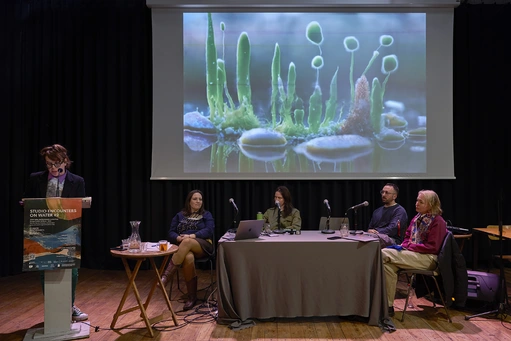
Studio for Interspecies Inquiry
Presenting the Studio for Interspecies Inquiry, Janine Armin presented her collaborative work with Yashaswini Raghunandan and Zigmunds Lapsa, titled Fungus Knats, which was also on show at the Unimaginable: Clarion Calls from Rising Seas exhibition. For this three-part piece, Armin took insight from the early multimedia book Atalanta Fugiens (1617), featuring mercury, sulphur and salt to create a poetic, subtle, but very rich and embodied soundscape, paired with an illustrated publication. Filmmaker and sound designer Raghunandan’s sound piece against an ebbing sea takes ‘a few objects under dripping taps before they totally dry up’ during a March drought; Lapsa feedbacks and balances visual elements in his book design, which Armin supports with a poem.
Carlo De Gaetano explained how he uses fiction to evoke reflections about the interconnectedness between humans, nature, and other beings. He talked about his deep dives into the audiovisual collections from various Institutes to understand how bodies of water and their ecosystems are represented. He has worked with hundreds of videos from the open archives of the Netherlands Institute for Sound & Vision and with imaginaries generated during workshops in which participants were invited to use archival materials as a starting point for thinking about a future with rising sea levels. The outcomes of the workshops and the original archival materials informed his video installation It happened tomorrow, which was shown at Unimaginable: Clarion Calls from Rising Seas and features fictional letters from a researcher visiting the Netherlands in 2124. In his work, Carlo uses Generative AI as a co-fabulator in queering the boundaries between past and future, human and more than human, shaping tiny climate fictions that invite us all to reimagine ourselves as part of nature.
Femke Dekker talked about sound as an agent for making. Known under her artist moniker Loma Doom, her style revolves around electronic experimentalism, both for the mind and movement. Using radio and archives as her main media, her current focus is on various notions of listening and how listening is a call to action. She presented her listening exercise that was part of Unimaginable: Clarion Calls from Rising Seas, titled Echo Ocean, as a call to action and, in Pauline Oliveros’ words, “Listen to everything all the time and remind yourself when you are not listening.”
Carlo De Gaetano explained how he uses fiction to evoke reflections about the interconnectedness between humans, nature, and other beings. He talked about his deep dives into the audiovisual collections from various Institutes to understand how bodies of water and their ecosystems are represented. He has worked with hundreds of videos from the open archives of the Netherlands Institute for Sound & Vision and with imaginaries generated during workshops in which participants were invited to use archival materials as a starting point for thinking about a future with rising sea levels. The outcomes of the workshops and the original archival materials informed his video installation It happened tomorrow, which was shown at Unimaginable: Clarion Calls from Rising Seas and features fictional letters from a researcher visiting the Netherlands in 2124. In his work, Carlo uses Generative AI as a co-fabulator in queering the boundaries between past and future, human and more than human, shaping tiny climate fictions that invite us all to reimagine ourselves as part of nature.
Femke Dekker talked about sound as an agent for making. Known under her artist moniker Loma Doom, her style revolves around electronic experimentalism, both for the mind and movement. Using radio and archives as her main media, her current focus is on various notions of listening and how listening is a call to action. She presented her listening exercise that was part of Unimaginable: Clarion Calls from Rising Seas, titled Echo Ocean, as a call to action and, in Pauline Oliveros’ words, “Listen to everything all the time and remind yourself when you are not listening.”
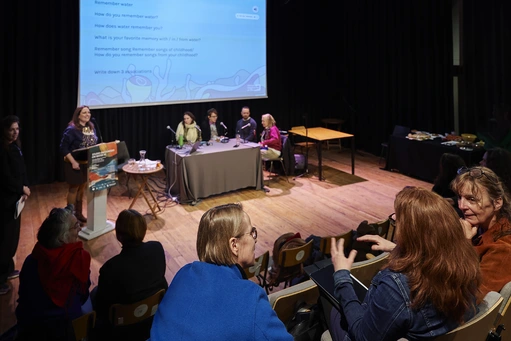
Studio on global South and Indigenous perspectives
The AHK Studio on global South and Indigenous perspectives was presented by Leanne Betasamosake Simpson, Joy Brandsma, Dorothy Blokland and Mikki Stelder.During the Festival, the AHK Studio was honoured to host Leanne Betasamosake Simpson as an artist in residence: a renowned Michi Saagiig Nishnaabeg writer, musician, academic and activist. For the Open Studio, Leanne presented a keynote lecture ‘Theory of Water’ centring the Nishnaabeg understanding of water as a living being with agency; and in Unimaginable, she exhibited the video work, Solidification which combines a reading from her novel "Noopiming: The Cure for White Ladies" with a soundscape of drone and vocals composed by her sister Ansley Simpson. Within the studio, Leanne worked with students of the Master Creative Producing who explored how the principle of reciprocity and other values embedded in Anishinaabe practice might inform their own emerging visions as creative producers seeking to make a difference in the Dutch cultural sector.
Also for Unimaginable, Mikki Stelder created the video-essay Attending to the Leusden. Originally emerging as an academic essay, the video iteration seeks to shore up against the limitation of the academic form in the wake of the Leusden massacre.
The AHK Studio also shared The Power of Water project led by theatre-maker Dorothy Blokland and researcher Joy Brandsma. The Power of Water uses photography and spoken word to empower children in Suriname and Amsterdam to share their stories and perspectives on climate justice - starting from the photo exhibition “See the world through your photo lens” by partners Villa Zapakara, the children’s museum in Paramaribo.
For the Open Studio, Joy Brandsma played her sound piece - part of the Unimaginable exhibition at Bradwolff Projects - inviting audiences to listen but also to respond through prompts to write creatively from their own embodied memories of song, water and childhood. The sound piece is a fragmented articulation of different methodologies within Joy’s research on cultural exchanges between Dutch and Surinamese children on climate change. The piece echoes moments from workshops organised by Dorothy Blokland as part of the Power of Water project (2023-25) - with partners Masterplan Zuid-Oost and Noordje - which has been highlighting the value of giving children agency within debates on sea level rise and climate change. The vocals and sound of this piece are by the Queer Choir Amsterdam, with voices and vocals from children that participated in Masterplan Zuidoost workshops.
During the Festival, Dorothy Blokland also offered a spoken word and movement workshop at VOX-POP, inviting participants - which included climate science professionals - to move and write from the point of view of water, earth, air and fire and to respond to the photographs of land and water taken by Surinamese children at Villa Zapakara.
Also for Unimaginable, Mikki Stelder created the video-essay Attending to the Leusden. Originally emerging as an academic essay, the video iteration seeks to shore up against the limitation of the academic form in the wake of the Leusden massacre.
The AHK Studio also shared The Power of Water project led by theatre-maker Dorothy Blokland and researcher Joy Brandsma. The Power of Water uses photography and spoken word to empower children in Suriname and Amsterdam to share their stories and perspectives on climate justice - starting from the photo exhibition “See the world through your photo lens” by partners Villa Zapakara, the children’s museum in Paramaribo.
For the Open Studio, Joy Brandsma played her sound piece - part of the Unimaginable exhibition at Bradwolff Projects - inviting audiences to listen but also to respond through prompts to write creatively from their own embodied memories of song, water and childhood. The sound piece is a fragmented articulation of different methodologies within Joy’s research on cultural exchanges between Dutch and Surinamese children on climate change. The piece echoes moments from workshops organised by Dorothy Blokland as part of the Power of Water project (2023-25) - with partners Masterplan Zuid-Oost and Noordje - which has been highlighting the value of giving children agency within debates on sea level rise and climate change. The vocals and sound of this piece are by the Queer Choir Amsterdam, with voices and vocals from children that participated in Masterplan Zuidoost workshops.
During the Festival, Dorothy Blokland also offered a spoken word and movement workshop at VOX-POP, inviting participants - which included climate science professionals - to move and write from the point of view of water, earth, air and fire and to respond to the photographs of land and water taken by Surinamese children at Villa Zapakara.
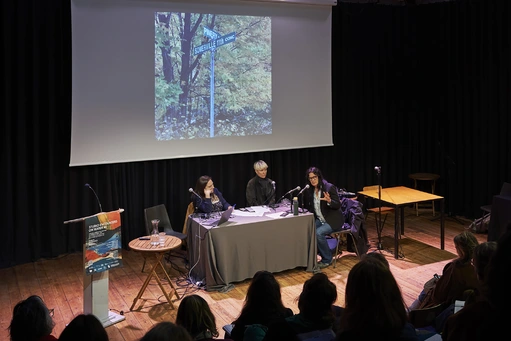
To conclude
The talks and performances resonated deeply with the works of the artist and researchers taking part in the exhibition. To name them all: Leanne Betasamosake Simpson, Müge Yilmaz (in collaboration with Travis A G Geertruida, Janis Rafa, Carlos Irijalba, and Jun Zhang), Carlo De Gaetano, Janine Armin (in collaboration with Zigmunds Lapsa and Yashaswini Raghunandan), Femke Dekker (Loma Doom), Joy Brandsma, Dorothy Blokland, and Mikki Stelder.
Thanks to the generous support of the Centre of Expertise for Creative Innovation, NWA arts route, the SPRONG programme - Imagination in transition and ARIAS, we will continue our artistic research to envision just and inclusive climate futures by challenging existing binaries between nature and culture, water and land, and humans and animals.
Thanks to the generous support of the Centre of Expertise for Creative Innovation, NWA arts route, the SPRONG programme - Imagination in transition and ARIAS, we will continue our artistic research to envision just and inclusive climate futures by challenging existing binaries between nature and culture, water and land, and humans and animals.
project
Climate Imaginaries at Sea speculates possible futures in and around water through various artistic and participatory research practices.
research group
Art & Spatial Praxis
Art & Spatial Praxis
project
Climate Imaginaries at Sea
Climate Imaginaries at Sea
